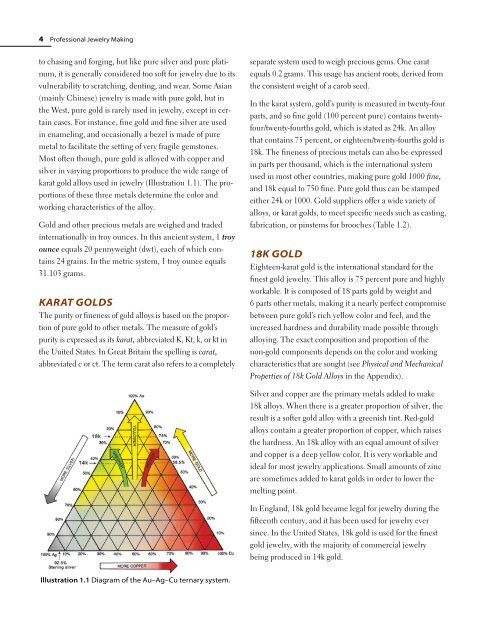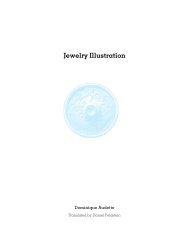Professional Jewelry Making - Brynmorgen Press
Professional Jewelry Making - Brynmorgen Press
Professional Jewelry Making - Brynmorgen Press
You also want an ePaper? Increase the reach of your titles
YUMPU automatically turns print PDFs into web optimized ePapers that Google loves.
4 <strong>Professional</strong> <strong>Jewelry</strong> <strong>Making</strong><br />
to chasing and forging, but like pure silver and pure platinum,<br />
it is generally considered too soft for jewelry due to its<br />
vulnerability to scratching, denting, and wear. Some Asian<br />
(mainly Chinese) jewelry is made with pure gold, but in<br />
the West, pure gold is rarely used in jewelry, except in certain<br />
cases. For instance, fine gold and fine silver are used<br />
in enameling, and occasionally a bezel is made of pure<br />
metal to facilitate the setting of very fragile gemstones.<br />
Most often though, pure gold is alloyed with copper and<br />
silver in varying proportions to produce the wide range of<br />
karat gold alloys used in jewelry (Illustration 1.1). The proportions<br />
of these three metals determine the color and<br />
working characteristics of the alloy.<br />
Gold and other precious metals are weighed and traded<br />
internationally in troy ounces. In this ancient system, 1 troy<br />
ounce equals 20 pennyweight (dwt), each of which contains<br />
24 grains. In the metric system, 1 troy ounce equals<br />
31.103 grams.<br />
kArAt golds<br />
The purity or fineness of gold alloys is based on the propor-<br />
tion of pure gold to other metals. The measure of gold’s<br />
purity is expressed as its karat, abbreviated K, Kt, k, or kt in<br />
the United States. In Great Britain the spelling is carat,<br />
abbreviated c or ct. The term carat also refers to a completely<br />
Illustration 1.1 Diagram of the au–ag–cu ternary system.<br />
separate system used to weigh precious gems. One carat<br />
equals 0.2 grams. This usage has ancient roots, derived from<br />
the consistent weight of a carob seed.<br />
In the karat system, gold’s purity is measured in twenty-four<br />
parts, and so fine gold (100 percent pure) contains twentyfour/twenty-fourths<br />
gold, which is stated as 24k. An alloy<br />
that contains 75 percent, or eighteen/twenty-fourths gold is<br />
18k. The fineness of precious metals can also be expressed<br />
in parts per thousand, which is the international system<br />
used in most other countries, making pure gold 1000 fine,<br />
and 18k equal to 750 fine. Pure gold thus can be stamped<br />
either 24k or 1000. Gold suppliers offer a wide variety of<br />
alloys, or karat golds, to meet specific needs such as casting,<br />
fabrication, or pinstems for brooches (Table 1.2).<br />
18k gold<br />
Eighteen-karat gold is the international standard for the<br />
finest gold jewelry. This alloy is 75 percent pure and highly<br />
workable. It is composed of 18 parts gold by weight and<br />
6 parts other metals, making it a nearly perfect compromise<br />
between pure gold’s rich yellow color and feel, and the<br />
increased hardness and durability made possible through<br />
alloying. The exact composition and proportion of the<br />
non-gold components depends on the color and working<br />
characteristics that are sought (see Physical and Mechanical<br />
Properties of 18k Gold Alloys in the Appendix).<br />
Silver and copper are the primary metals added to make<br />
18k alloys. When there is a greater proportion of silver, the<br />
result is a softer gold alloy with a greenish tint. Red-gold<br />
alloys contain a greater proportion of copper, which raises<br />
the hardness. An 18k alloy with an equal amount of silver<br />
and copper is a deep yellow color. It is very workable and<br />
ideal for most jewelry applications. Small amounts of zinc<br />
are sometimes added to karat golds in order to lower the<br />
melting point.<br />
In England, 18k gold became legal for jewelry during the<br />
fifteenth century, and it has been used for jewelry ever<br />
since. In the United States, 18k gold is used for the finest<br />
gold jewelry, with the majority of commercial jewelry<br />
being produced in 14k gold.




